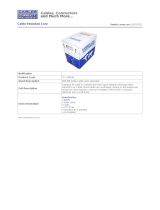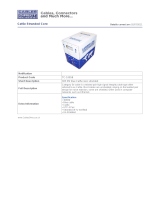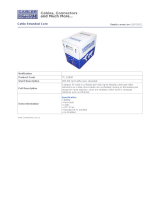Page is loading ...

www.gefen.com
®
Cat5 • 5500HD
EXT-CAT5-5500HD
USER MANUAL

Technical Support:
Telephone (818) 772-9100
(800) 545-6900
Fax (818) 772-9120
Technical Support Hours:
8:00 AM to 5:00 PM Monday thru Friday PST (Pacifi c Standard Time)
Write To:
Gefen, LLC
c/o Customer Service
20600 Nordhoff St.
Chatsworth, CA 91311
www.gefen.com
Notice
Gefen, LLC reserves the right to make changes in the hard ware, packaging, and any
accompanying doc u men ta tion without prior written notice.
The CAT5 5500HD is a trademark of Gefen, LLC
© 2010 Gefen, LLC. All rights reserved.
ASKING FOR ASSISTANCE
Rev X3
All trademarks are the property of their respective owners.`

TABLE OF CONTENTS
Introduction and Operation Notes
Features
How It Works / Front Panel Layouts
CAT5•5500HDS Back Panel Layout
CAT5•5500HDS Back Panel Function Descriptions
CAT5•5500HDR Back Panel Layout
CAT5•5500HDR Back Panel Functions Descriptions
Link Cable Wiring Diagrams
CAT5•5500HD - Wiring Diagram
Service Switch Usage Guide
Troubleshooting Guide
Terminology
Specifi cations
Warranty
1
2
3
4
5
6
7
8
9
10
11
12
13
14

READ THESE NOTES BEFORE IN STALL ING
OR OPERATING THE CAT5•5500HD SYSTEM
* The CAT5•5500HD units are housed in a metal box for better RF shielding.
* Your CAT-5 cable should not exceed 200 feet.
OPERATION NOTES
INTRODUCTION
Thank you for purchasing the Gefen CAT5•5500HD series
The Gefen CAT5•5500HD allows users the benefi ts of extending dual DVI displays and
USB beyond the desktop. In a growing number of applications, broadcast stations and
production facilities need to locate a computer remotely from the keyboard, mouse, and
video monitor. A CPU may need to be shared between several users, for example, or
moved to another room because of annoying fan noise.
The CAT5•5500HD series can be used to extend computers with noisy fans, printers, hard
drives, scanners, cameras, keyboards, mouse, and any other USB. With the potential to
cover the distance of 150 feet, industry standard Category 5 (CAT-5) cables are used for
the extension of all the devices.
1

2
FEATURES
Features
• Uses CAT-5 cable for DDC and control signals
• Extends any DVI (Digital Video Interface) compliant device up to 200 ft from the
computer
• 200 ft extension at 1280x1024
• 150 ft extension at 1920x1200
• Saves space on your desktop
• Increases productivity
• Eliminates computer noise where you work
• Supports VESA Standard resolutions and HDTV resolutions
• Supports DDWG standard for DVI compliant monitors
• HDCP Compliant

3
CONTENTS
The CAT5•5500HD system consists of:
--- (1) CAT5•5500HDS sender unit
--- (1) CAT5•5500HDR receiver unit
--- (2) 5 VDC power supplies
--- (2) DVI cable M-M (6FT)
--- (1) USB cable (6FT)
--- (1) Set of Rack Ears
--- (1) User Manual
HOW IT WORKS
The CAT5•5500HD sender unit sits next to your computer. The cables supplied with the
CAT5•5500HD connects your DVI source(s) and USB to the send unit. The CAT5•5500HD
receiver unit sits next to your DVI displays - up to 200 feet away. The displays and USB
plug into the back of the CAT5•5500HD receiver unit. Four CAT-5 cables connect the
CAT5•5500HD-S and the CAT5•5500HD-R units to each other.
HOW IT WORKS
FRONT PANEL LAYOUTS (SENDER & RECEIVER)
()
Power LED Indicators
(will glow red when unit is powered)

4
CAT5•5500HDS BACK PANEL LAYOUT
123 4 56 7
8
Sender

5
CAT5•5500HDS BACK PANEL FUNCTIONS
POWER - 5 VDC external power supply
CAT5 Video 1 - RJ-45 input extends DVI input 1 with CAT-5 cable
CAT5 USB/DDC1 - RJ-45 input extends USB and DDC1 signals with CAT-5 cable
DVI IN 1 - DVI Input connects to your computer
CAT5 Video 2 - RJ-45 input extends DVI input 2 with CAT-5 cable
CAT5 USB/DDC2 - RJ-45 input extends USB and DDC2 signals with CAT-5 cable
DVI IN 2 - DVI Input connects to your computer
USB IN - USB Input from computer
1
2
3
4
5
6
7
8

6
CAT5•5500HDR BACK PANEL LAYOUT
12 3 4 5 6 7
8
Receiver

7
CAT5•5500HDR BACK PANEL FUNC TIONS
POWER - 5 VDC external power supply
CAT5 USB/DDC1 - RJ-45 input extends USB and DDC1 signals with CAT-5 cable
CAT5 Video 1 - RJ-45 input extends video input 1 with CAT-5 cable
DVI OUT 1 - DVI output connects to the monitor 1 for local video
CAT5 USB/DDC2 - RJ-45 input extends USB and DDC2 signals with CAT-5 cable
CAT5 Video 2 - RJ-45 input extends video input 2 with CAT-5 cable
DVI OUT 2 - DVI output connects to the monitor 2 for local video
USB OUT - USB Output to devices
1
2
3
4
5
6
7
8

8
CAT5 LINK CABLE - WIRING DIAGRAM
White/Orange
Orange
White/Green
Blue
White/Blue
Green
White/Brown
Brown
RJ-45 Jack
RJ-45 Jack
2
3
4
5
6
7
8
1
2
3
4
5
6
7
8
1
1
8
1
8

9
CAT5•5500HD WIRING DIAGRAM
EXT-CAT5-5500HD
Sender
Receiver
Computer
DVI Monitor
DVI Monitor
USB CABLE
DVI CABLE
CAT-5 CABLE
(Up To 330 Ft)
USB Mouse
USB Keyboard
USB Printer
USB External HDD

10
SERVICE SWITCH USAGE GUIDE
Gefen CAT5 Extreme products (sender and receiver) both contain a pair of service
switches (also called dip switches) located underneath the unit. These service
switches are used to select from sets of confi gurations that will equalize the signal to
best match the conditions in your setup. For the CAT5•5500HD, there are 1 set of
switches for each monitor under both the sender and receiver units. The switches are
hidden beneath black stickers. Each bank of dip switches have 4 switches. Switches 3
and 4 are not used. (*Note: Adjustments should be done with sources and display on.)
Sender Dip Switch Settings
Setting Switch 1 Switch 2
No Boost OFF ON
Normal Boost (Default) OFF OFF
Strong Boost ON OFF
Undefi ned ON ON
Receiver Dip Switch Settings
Setting Switch 1 Switch 2
No EQ (Default) OFF OFF
EQ Setting 2 ON OFF
EQ Setting 3 OFF ON
Maximum EQ ON ON
Adjustment Guidelines:
1) Strong boost should not be used on stranded cables. Strong boosting will cause
pixels or no picture on these cables.
2) Using the wrong settings will not damage the units; it will either produce no
image or a noisy image.
3) To eliminate the possibility of cross talk and interference, cables must be
terminated with 568B scheduling. (See page 8 for details)

11
Frequently Asked Questions
What kind of CAT-5e cable should I be using?
Solid core CAT-5e cable rated at 350 Mhz and terminated in 568a or 568b is the
minimum requirement. For resolutions greater than 1280x1024 or 1080i, Gefen
recommends solid CAT-6 cables.
I’m getting no video on the screens, what can I check?
First thing to check is make sure that the video CAT5 is linked to the other video CAT5 port
and the same with the DDC ports. Test to make sure the units are working with short CAT-5e
cables 15-20 feet. You can also make sure you have the correct boost setting confi gured
(refer to page 10).
I’m getting no video on the screens using ADC to DVI adapters, what is wrong?
ADC to DVI adapters remove the necessary 5V line that the extenders require on the input
to operate. To enable the 5V you will need to open up the sender unit. Next to each DVI
input connector will be a jumper that needs to be shorted to enable 5V to the input. This
should only be enabled when using a ADC to DVI Adapter otherwise damage to your video
card may result.
How can I fi x the fl ickering picture?
Flickering or a blinking image is the result of a loss of sync between the display and the
source. Try lowering the resolution to see if that helps, if it does, the CAT-5 cables you
are using are unable to handle the bandwidth of the higher resolution and thus you are
losing sync. Try a shielded CAT-6 cable on the video line to reduce interference. You
can also try adjusting the service switches. Usually this is caused by EMI and a shielded
CAT-6 with metal RJ-45 connectors with the drain wire soldered to the connectors will
resolve the issue. Please refer to the service switch guide on page 10 for the different
combinations.
Can I run the CAT-5 cable through a patch bay?
No, the signal will not transmit reliably.
TROUBLESHOOTING GUIDE

12
CAT-5
Category 5 cable, commonly known as Cat 5, is an unshielded twisted pair type cable
designed for high signal integrity. The actual standard defi nes specifi c electrical properties
of the wire, but it is most commonly known as being rated for its Ethernet capability of 100
Mbit/s. Its specifi c standard designation is EIA/TIA-568. Cat 5 cable typically has three
twists per inch of each twisted pair of 24 gauge copper wires within the cable.
CAT-5e
Similar to Cat 5 cable, but is enhanced to support speeds of up to 1000 megabits per
second
DDC
Short form for Display Data Channel. It is a VESA standard for communication between
a monitor and a video adapter. Using DDC, a monitor can inform the video card about its
properties, such as maximum resolution and color depth. The video card can then use
this information to ensure that the user is presented with valid options for confi guring
the display
DDWG
Digital Display Working Group DDWG are the creators of the DVI specifi cation.
DVI
Digital Visual Interface. Connection standard developed by Intel for connecting computers
to digital monitors such as fl at panels and DLP projectors. A consumer electronics version,
not necessarily compatible with the PC version, is used as a connection standard for
HDTV tuners and displays. Transmits an uncompressed digital signal to the display. The
latter version uses HDCP copy protection to prevent unauthorized copying
USB
Universal Serial Bus. An external peripheral interface standard for communication between
a computer and external peripherals over a cable using bi-serial transmission.
VESA
Video Electronic Standards Association, a consortium of manufacturers formed to
establish and maintain industry wide standards for video cards and monitors. VESA was
instrumental in the introduction of the Super VGA and Extended VGA video graphics
standards with a refresh rate of 70 Hz, minimizing fl icker and helping to reduce user
eyestrain and fatigue.
PS/2
A port type developed by IBM for the purpose of connecting a keyboard or mouse to a
PC. The PS/2 port has a mini DIN plug containing 6 pins. PS/2 ports are used so that
the serial port can be used by another device. The PS/2 port is often called the mouse
port.
TERMINOLOGY

Video Amplifi er Bandwidth: ................................................................................165 MHz
Single Link Range: ............................................................................1080P/1920 x 1200
Input Video Signal: ........................................................................................1.2 volts p-p
Input DDC Signal: ...................................................................................5 volts p-p (TTL)
DVI Connector: ............................................................DVI-I (29 pin) female (digital only)
USB Input: ..................................................................................USB type "B" connector
USB Output: .......................................................................two USB type "A" connectors
Link Connector: ........................................................................................RJ-45 Shielded
Power Supply: ........................................................................................................5V DC
Power Consumption: .................................................20 Watts (max) each power supply
Dimensions(S): ..............................................................................4.2''D x 8.4''W x 1.6''H
Dimensions(R): ...........................................................................4.2''D x 17.1'' W x 1.6''H
Shipping Weight: .......................................................................................................7 lbs
SPECIFICATIONS
13

14
WARRANTY
Gefen warrants the equipment it manufactures to be free from defects in material and workmanship.
If equipment fails because of such defects and Gefen is notifi ed within two (2) years from the date of shipment, Gefen will, at its option,
repair or replace the equipment, provided that the equipment has not been subjected to mechanical, electrical, or other abuse or
modifi cations. Equipment that fails under conditions other than those covered will be repaired at the current price of parts and labor in effect
at the time of repair. Such repairs are warranted for ninety (90) days from the day of reshipment to the Buyer.
This warranty is in lieu of all other warranties expressed or implied, including without limitation, any implied warranty or merchantability or
fi tness for any particular purpose, all of which are expressly disclaimed.
1. Proof of sale may be required in order to claim warranty.
2. Customers outside the US are responsible for shipping charges to and from Gefen.
3. Copper cables are limited to a 30 day warranty and cables must be in their original condition.
The information in this manual has been carefully checked and is believed to be accurate. However, Gefen assumes no responsibility
for any inaccuracies that may be contained in this manual. In no event will Gefen be liable for direct, indirect, special, incidental, or
consequential damages resulting from any defect or omission in this manual, even if advised of the possibility of such damages. The
technical information contained herein regarding the features and specifi cations is subject to change without notice.
For the latest warranty coverage information, refer to the Warranty and Return Policy under the Support section of the Gefen Web site at
www.gefen.com.
PRODUCT REGISTRATION
Please register your product online by visiting the Register Product page under the Support section of the Gefen Web site.


*ma-cat5-5500Hd*
Rev X3
Pb
20600 Nordhoff St., Chatsworth CA 91311
1-800-545-6900 818-772-9100 fax: 818-772-9120
www.gefen.com [email protected]
This product uses UL listed power supplies.
/



